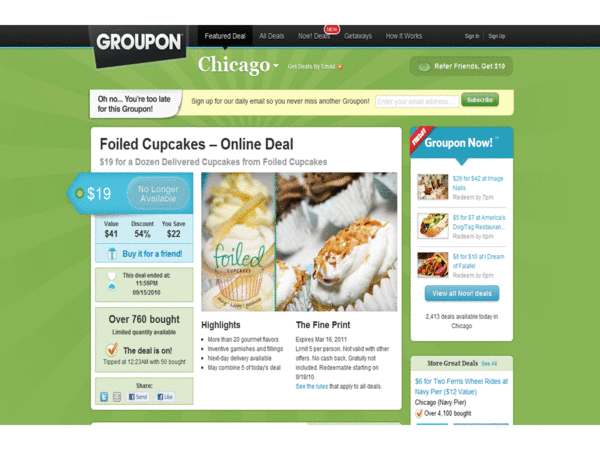Groupon and LivingSocial, known as “social buying sites,” are forerunners in what Forrester says is the new social economy. They are innovations. For the first time, a business requires just the internet, not a store or a street corner or advertising, to promote a brand to consumers.
If you’re considering them for your brand, you want customers to buy, only not too much. There’s also more know-how involved than you might imagine to manage. If helps to learn from someone whose had experience, here’s a case in point.

At a Social Media Mini-MBA that Rutgers University offers, I’m fortunate to teach the Social Media ROI curriculum. Last week, Mari Luangrath, founder of Foiled Cupcakes, was our guest. Mari, in my opinion, is one of the best social economy practitioner in the country.
As the name communicates, Foiled Cupcakes sells cupcakes, only they have no storefront. They do it from a website. The company has shown extraordinary growth, strong ROI and built a social community where 95% of their customers come from Facebook, Twitter and LinkedIn.
When someone in the class Q&A asked Mari about Foiled Cupcakes’ experiences from their Groupon event uptop, she had some great advice.
Here are 10 tips on Groupon or LivingSocial and the pros and cons for your brand.
- SOCIAL BUYING SITES DON”T OFFER A SUSTAINABLE SALES MODEL: The basic economics of social buying sites is sell a product for 50% off and Groupon or LivingSocial take half of the 50% that’s left. Can you sell your brand for 75% off for long?
- OFFER A “TEST DRIVE” TO A SELECT FEW: Social buying sites work because they offer a reduced price for a limited amount of time with an urgency to act. This benefit worked for Foiled Cupcakes because they limited the offer to 800 dozen.
- MINIMIZE OUT-OF-POCKETS COSTS: Foiled Cupcakes didn’t have to bake the cupcakes until they knew how many were ordered and paid.
- MEASURE DEMAND IN HOURS AND MINUTES: In a store, you can see how quickly your product is consumed. On the internet, the equivalent metric is time. In the case of Foiled Cupcakes, the promotion went live at midnight. By 8 am, the 800 dozen were sold.
- DON’T OVERLOADING THE OPERATIONS: Foiled cupcakes knew how much they could produce before it was a problem.
- RECOGNIZE CUSTOMERS ARE VERY SAVVY: People who shop on social buying sites are some of the savviest shoppers on the internet. They frequently shop these sites on price, ask a lot of questions and know and, if treated badly, they have the recourse to write a bad review.
- EXPECT TO SHOW SIGNIFICANT CUSTOMER SERVICE: Mari and the Foiled Cupcakes crew found themselves up all night answering questions when they saw the traffic they were getting.
- FOLLOW UP WITH A SURVEY TO SEPARATE THE WHEAT FROM THE CHAFF: Customers range from those who: 1) Buy only on sale, 2) buy on sale but are willing to pay full price, 3) are high maintenance, 4) are low maintenance, 5) show appreciation and 6) show no appreciation.
- LEARN WHO YOUR BRAND ATTRACTS: The key learning is did Groupon or LivingSocial attract new people who now buy your brand at full price to make it worthwhile? For Foiled Cupcakes, they gained new corporate accounts proving the hard work was worth the effort.
- REPEAT WHEN NECESSARY: If this works for your brand, congratulations, the ROI of social buying site pays out and now you have a new tool in your marketing toolkit. One that likely to be a part of the internet economy for some time to come.
I’m not the only one who teaches this Social Media Mini-MBA at Rutgers. There is also Matt Bailey, Heidi Cohen, Augustine Fou, Glenn Gilmore, Greg Jarboe, Christina “CK” Kerley, Mark Moran and Mark Schaefer. As far as I know, Rutgers is one of the first universities in the country to offer a Social Media Mini-MBA, thanks to Eric Greenberg and his team who put this all together.
I’m also grateful Mari Luangrath drops by from time to time because I never stop learning from her.





[…] FOILED CUPCAKES: Has shown extraordinary growth, strong ROI and built a social community where 95% of their […]